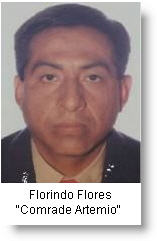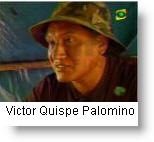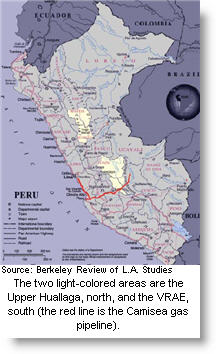The United States Department of State has placed the leaders of two Shining Path factions on its narcotics rewards program, which offers compensation of $5 million for information leading to the arrest or conviction of the targets.
The announcement comes only weeks after a UN Office on Drug Control and Crime (UNODC) report, questioned by the Peruvian government, indicated that Peru’s coca production increased 6.8% in 2009 to overtake Colombia’s production.
 Florindo Eleuterio Flores Hala, also known as “Comrade Artemio,” operates the Proseguir, or “to continue,” group’s remaining 200-300 insurgents based in Peru’s Huallaga Valley.
Florindo Eleuterio Flores Hala, also known as “Comrade Artemio,” operates the Proseguir, or “to continue,” group’s remaining 200-300 insurgents based in Peru’s Huallaga Valley.
“Flores Hala himself is involved in the local cocaine trade in the Huallaga Valley, since he repeatedly invests his own and/or [Shining Path] money in drug trafficking ventures with local drug traffickers,” the State Department says on its website.
“Flores Hala also repeatedly uses violence against Peruvian National Police officers, other government personnel, and the local population in order to achieve his goals.”
 The State Department also announced a reward for Victor Quispe Palomino, the leader of Shining Path remnants based in the Apurimac and Ene River Valley’s (VRAE) whose alias is “José.”
The State Department also announced a reward for Victor Quispe Palomino, the leader of Shining Path remnants based in the Apurimac and Ene River Valley’s (VRAE) whose alias is “José.”
“The drug trafficking activities of this faction of [the Shining Path] include taxes/extortion payments charged to local drug traffickers in exchange for security of cocaine labs and cocaine shipments made throughout the VRAE,” the State Department says.
“Furthermore, currently [the Shining Path] owns several coca plots and cocaine base laboratories in the VRAE. This faction is also notorious for engaging in well-coordinated and extremely violent attacks against Peruvian National Police and Peruvian military personnel.”
 The Upper Huallaga Valley in Huánuco region and the VRAE -the Apurimac and Ene Valleys, which include 31 districts in the departments of Ayacucho, Cuzco, Huancavelica and Junin- are Peru’s top coca growing regions. In the Upper Huallaga Valley 17,497 hectares were used to produce coca in 2009, while in the VRAE 17,486 ha were used for coca (map from the Berkeley Review, Spring 2009)
The Upper Huallaga Valley in Huánuco region and the VRAE -the Apurimac and Ene Valleys, which include 31 districts in the departments of Ayacucho, Cuzco, Huancavelica and Junin- are Peru’s top coca growing regions. In the Upper Huallaga Valley 17,497 hectares were used to produce coca in 2009, while in the VRAE 17,486 ha were used for coca (map from the Berkeley Review, Spring 2009)
The two splinter groups, despite calling themselves the Shining Path, now have little or anything to do with the pro-Maoist rebel group founded by Abimael Guzmán, which at its peak in the 1980s had approximately 5,000 militants and almost brought the country to its knees with car bombings, brutal massacres and assassinations, and brazen attacks on police and military outposts. The rebel group was seriously diminished when Guzmán was arrested in 1992, and remnants managed to elude law enforcement in the high jungle of Huanuco.
Twenty years later, these factions hold to none of Guzman’s original beliefs/goals and focus entirely on narcoterrorism, controlling certain coca production areas and generating their income from illegal drug traffic.





